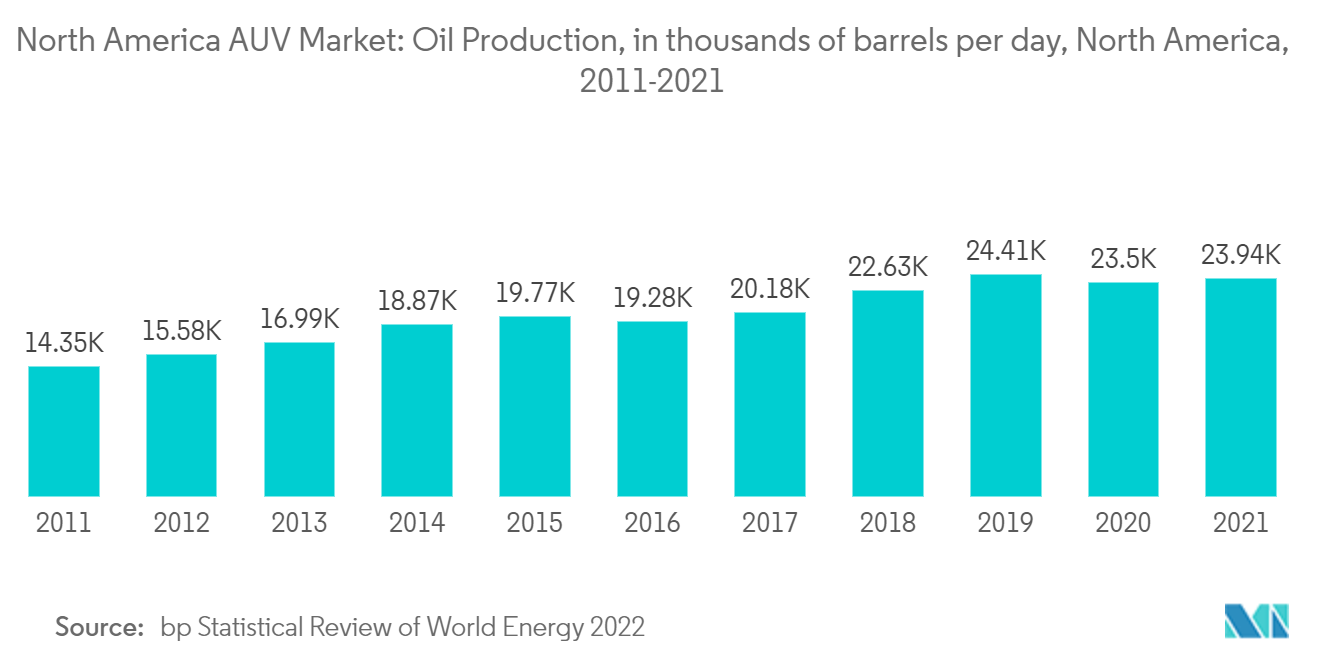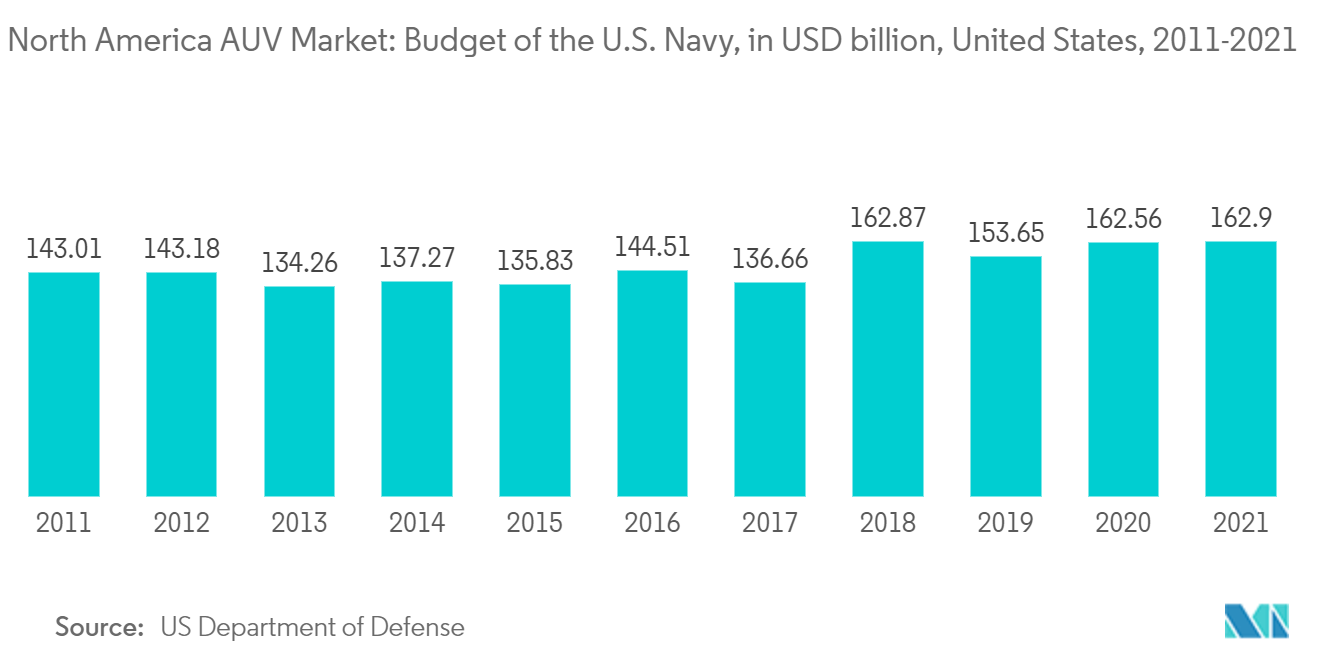Market Trends of North America AUV Industry
This section covers the major market trends shaping the North America AUV Market according to our research experts:
Oil and Gas Application to Dominate the Market
An offshore platform is an oil and gas production facility that is located offshore. Historically, oil and gas were generally produced on the ground. Nonetheless, offshore oil and gas development has become increasingly important since there are fewer fossil fuel-rich sites that can be accessed from the ground. The number of offshore oil and gas production facilities in the world was more than 3,000 in 2016, and that number is expected to increase.
As offshore platforms have a large number of subsea structures, such as pipelines, inspection and maintenance of these structures are of utmost importance. It is impossible for humans to dive and inspect some platforms, however, because they are installed in water depths of hundreds of meters. Because AUVs do not have wires, they can overcome this problem. Their operation flexibility is their greatest advantage. It is crucial for AUVs to ensure the accuracy of position sensing in order to take advantage of this flexibility.
AUVs are the preferred support system for deepwater drilling rigs and pipeline systems that can operate at depths of two miles. These wells and pipeline systems can be inspected, repaired and maintained using AUVs. Due to the rise in the installation of underwater infrastructure for oil and gas field development, AUVs have become almost indispensable in the oil and gas industry. There have been a number of new oil and gas discoveries in the region, both shallow and deepwater, which has resulted in an increase in the demand for AUVs.
With the rising number of maturing onshore oilfields in recent years, there has been growth in offshore exploration and production (E&P) activities. According to the United States Energy Information Administration, The new fields that were planned to be online in 2022 are expected to account for 5% of natural gas production and 14% of crude oil production by the end of 2023 in the US Federal Offshore Gulf of Mexico (GOM). The GOM natural gas production is also expected to average 2.1 billion cubic feet per day (Bcf/d) in 2023, down 0.1 Bcf/d from 2022. GOM crude oil production is expected to average 1.8 million barrels per day (MMb/d) in 2023, about the same as in 2022.
In July 2022, according to the Biden administration's five-year plan, all offshore oil drilling in the Atlantic and Pacific oceans was to be banned, while some drilling in the Gulf of Mexico and the south coast of Alaska was expected to be allowed. In response to rising energy prices, the fossil fuel sector has urged the administration to increase offshore drilling to reduce gas prices.
In February 2022, BP began operations at its Herschel expansion project in the Gulf of Mexico. As part of the first phase of the project, a subsea production system was to be developed, as well as the first of up to three wells to be drilled from the Na Kika platform. The first well will increase the platform's annual gross production by 10,600 barrels of oil equivalent per day. According to the bp statistical review of world energy, In 2021, North Amrerica produced 23,942 thousand barrels per day of oil, an increase of 21.1% from 2015.
Hence, increasing investments in the deepwater activities in the region is driving the North American UAV market.

United States to Dominate the Market
North America has been one of the market leaders in terms of the oil and gas sector. This is due to the fact that the United States has been the world's largest crude oil producer since 2018 and has retained the position through 2021.
In terms of offshore segment, floating rigs are most often used for exploratory drilling and drilling in waters deeper than 3,000 feet. As of June 2022, the United States stood among the top three countries across the world in terms of the demand for floating assets (semisubmersibles and drillships). In March 2022, Shell Offshore Inc. announced the start of production at PowerNap, subsea development in the United States, with estimated peak production of 20,000 barrels of oil equivalent per day (boe/d). Such developments are expected to accelerate offshore oil production in the country, increasing the demand for the usage of AUVs.
There are a variety of military applications for autonomous underwater robots, including intelligence, surveillance, and reconnaissance (ISR), mine countermeasures, inspections and identification, oceanography, and payload delivery. The largest class of AUVs can be used for anti-submarine warfare and time-critical missions. The US Navy classifies AUVs into four categories: man-portable vehicles, lightweight vehicles, heavyweight vehicles, and extra-large vehicles.
According to the US Department of Defense, the United States had issued a budget of a total of USD 162.9 billion for military applications for the US Navy in 2021, marking a growth of 6% from 2019. The Unmanned Task Force of the US Navy spent nine months developing a venture capital model for selecting promising technologies. It is now in the process of identifying candidates that may have the potential to solve some problems facing warfighters in the next five years. In 2022, as of August, the task force has been working. In January, an initial cross-functional pilot program was launched. During this pilot program, the Unmanned Task Force worked with the US Fleet Forces Command and the US Pacific Fleet to identify specific operational problems that could be solved by unmanned systems.
On April 28, 2022, the US Navy's Naval Sea Systems Command (NAVSEA) marked an important milestone in its effort to develop reliable undersea capability by christening and testing the Orca Extra Large Unmanned Undersea Vehicle (XLUUV) Test Asset System in Huntington Beach, California. Orca is an autonomous underwater vehicle (AUV) that is under development by Boeing and Huntington Ingalls Industries for the United States Navy. An order for four Orca Extra Large Unmanned Undersea Vehicles (XLUUV) with associated support elements has been awarded to Boeing for USD 43 million by the US Navy.
AUVs are expected to be used more frequently in the defense sector as a result of these developments, leading to growth in the market studied. Therefore, based on the above-mentioned factors, the United States is expected to become the fastest-growing AUV market during the forecast period.


